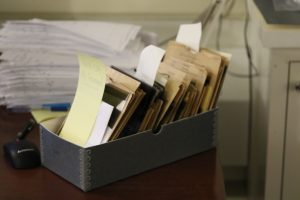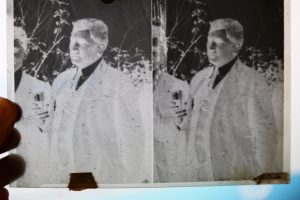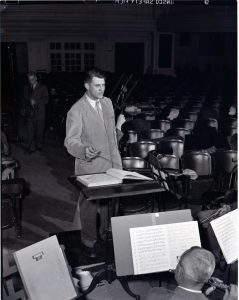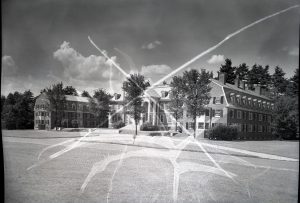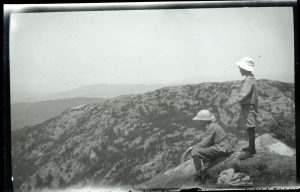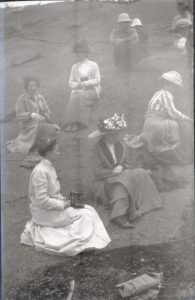On February 13, the Valley News published an online article by Dave Bailey exploring the aesthetic history of the Dartmouth men’s ice hockey team’s jerseys. Inspired by the introduction of a new alternate jersey this year, the article features an image gallery comparing the team’s various jersey designs dating back to the 1928-29 season. Bailey acknowledges the Digital Library Program’s Photographic Files image collection as a source “invaluable to [his] research”. View more of the history of hockey at Dartmouth, or learn about other topics of your choice, by exploring the Photo Files collection yourself!
Tag Archives: photo files
Inglourious Nitrates
Nitrate film, or nitrocellulose, is a highly combustible material that was used in commercial film production in the first half of the twentieth century. Several theater fires, resulting in the deaths of hundreds of people, have been attributed to it. Quentin Tarantino used it as a plot device in his 2009 alternate-history WWII movie Inglourious Basterds (spoiler alert): a Jewish cinema proprietor gets her revenge on an assemblage of Nazi leaders (including Hitler) by igniting a collection of nitrate film. Given that it is prone to spontaneous combustion as it deteriorates, nitrate film is not a material that most libraries and archives want sitting around in their collections, despite its utility in disposing of Nazis.
Recently, the Digital Library Program embarked on a project to digitize a collection of negatives held at Rauner Library that we suspected might contain nitrate film (as well as acetate safety film, which replaced nitrate film around 1950). Given the potentially hazardous nature of the materials, our process has several steps. The negatives are stored in our Preservation freezer; keeping nitrates at low temperatures has been shown to inhibit combustion. We digitize the negatives according to a process similar to our other workflows: the items are defrosted, accession numbers are assigned, images are captured
with the scanner, metadata from the negatives’ envelopes are associated with the image files, and the materials are returned to the freezer, to be discarded eventually.
The objective of the project is to preserve the content of the original materials. We’re finding images similar to those in our photo files: campus buildings, sporting events, fraternity and student organization formals, New Hampshire landscapes, and portraits of faculty and administrators. Nitrate film was prized for its depth of detail and the luminosity of the silver emulsion.
Image of the Week
Image
Our series examining an Image of the Week from the photographic files, by Kevin Warstadt, Edward Connery Lathem ’51 Digital Library Fellow.
No information is provided as to the identity of the woman or the elephant in this photo. However, it’s possible that the elephant is Queenie of the Rare Bird and Animal Farm of Fairlee, Vermont.
The Rare Bird and Animal Farm was founded by Bill Green in the early 1950s. Green, the child of a wealthy New Jersey family, developed a love of the outdoors at an early age. As an adult he began to travel, collecting animals on his many trips across the world. He purchased the Brackett Farm in Fairlee to house his growing collection of exotic animals, Queenie among them. The farm was opened to the public in 1954 at 75 cents admission.
Queenie was born in 1952 in Siam (now Thailand). She was purchased by Green in 1953 from Trefflich’s Pet Shop, New York City. She lived at the Rare Bird and Animal farm until 1967, and was introduced to water skiing by Marj and Jim Rusing of De Leon Springs, Florida, during this time. The unique performance earned the elephant and her owners some fame, and she became known as “The World’s Only Water Skiing Elephant.”
After the closure of the Rare Bird and Animal Farm, Queenie spent a number of years in various circuses. She was retired from the circus in 2003 and lived out the rest of her days at Wild Adventures theme park in Valdosta, GA.
Image of the Week
Image
Our series examining an Image of the Week from the photographic files, by Kevin Warstadt, Edward Connery Lathem ’51 Digital Library Fellow.
John F. Kennedy came to Dartmouth in March 1960 during his presidential campaign. He can be seen here en route to Dartmouth Hall, where he gave a speech on President Eisenhower’s tour of South America in February of that year. Of the visit, Kennedy’s spokesperson said that the Senator was “looking forward to being at Dartmouth and meeting students and townspeople even though he is a Harvard man.”
Kennedy suffered from a number of health problems throughout his life, including chronic lower back pain. In this image, one can make out the signs of that affliction.
Eight months later, he would defeat Richard Nixon in the 44th quadrennial presidential election, with running mate Lyndon B. Johnson.
Image of the Week
Image
First in our series examining an Image of the Week from the photographic files, by Kevin Warstadt, Edward Connery Lathem ’51 Digital Library Fellow.
This photo comes from the Dartmouth photographic file entitled “Dartmouth in China“. A candid shot, it seems to capture the feel of life on a Chinese street in the early twentieth century with an eerie authenticity. It was likely taken sometime around 1920 in Zhili (now Hebei) province in North China.
Dartmouth has a long history in China dating back to the late nineteenth century, when missionaries associated with the College began moving there to convert the populace. Charles Daniel Tenney was Dartmouth’s most significant representative from this group. He became a confidant of Li Hongzhang, the influential politician and diplomat of the late Qing Dynasty, and later became the Commissioner of Education for the reformist government of Northern China. Tenney’s papers can be found in the the Dartmouth Digital Collections.


